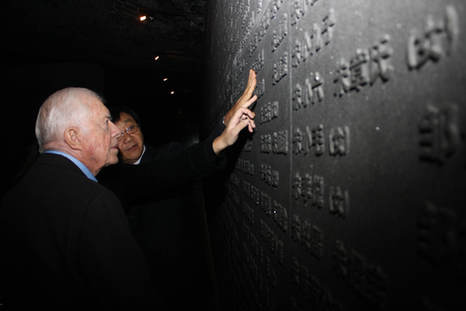Memorialize the Victims of the Nanjing Massacre
A Bond for History and Peace
The Memorial Hall of the Victims of the Nanjing Massacre by Japanese Invaders is an important platform for commemorative activities. Having been expanded several times, the memorial hall now occupies a gross area of 7.4 hectares with floor space of 25,000 square meters. It houses over 150,000 exhibits and receives more than six million visitors per year. Over 10,000 victims’ names are carved on the memorial wall.
In addition, the memorial hall is a bond for promoting peaceful interactions between China and the world. It has held exhibitions in more than 50 foreign cities and arranged for survivors to give testimony in Japan, making a significant contribution to proving historical facts and passing down historical memory.
Over the past 29 years, Japan’s Japan-China Society has organized annual visits to China to plant trees in Nanjing. This practice is called “green atonement.” Other Japanese peace organizations attend peace rallies in Nanjing annually.
Visitors to the memorial hall have also left countless moving messages. “This is testimony to the horrors of war and the need for peace in all nations,” wrote former U.S. president Jimmy Carter. Visitors from Japan are impressed by the exhibitions as well. After visiting the memorial hall on December 13, 2013, Takaiane Yasunori, a professor from University of Nagasaki, said, “I am shocked by all of the photos exhibited here. In the past, I always heard how Japan had been hurt by that war, but this is not the whole story. Japanese people need to know that Japan was the aggressor during WWII, and more importantly, they need to know about Japan’s cruel crimes against the Chinese people.”
 |
|
Zhu Chengshan and former U.S. President Jimmy Carter in front of the memorial wall engraved with victims’ names on December 14, 2012. |
Remember, but not to Hate
Although many Japanese are penitent about the Nanjing Massacre, some people in Japan still refuse to acknowledge it. Revisionists claim that it “probably never happened” or that it is “the biggest lie of the 20th century.”
In 1998, Shudo Higashinakano, an Asia University scholar, defamed Xia Shuqin in Complete Investigation into the Nanjing Massacre by saying that Xia had fabricated her story. The book stung Xia Shuqin, who sued Shudo Higashinakano for defamation. Zhu Chengshan submitted his testimony in support of Xia to the local court of Tokyo and traveled to Japan with Xia to handle the case. Seven years later, a Tokyo court gave a judgement in Xia’s favor and ordered compensation of RMB 260,000.
